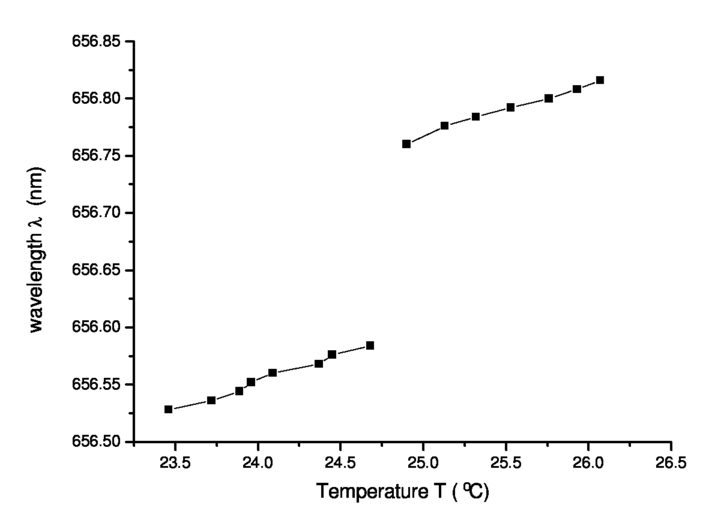|
|
1.IntroductionIn heterodyne-type optical communications or some kinds of fiber-optic measurement, the polarization state of the received signal must be kept constant. To meet this requirement, various birefringent fibers have been developed in which the propagation constants of two orthogonally polarized modes (HEx and HEy) are different. The degree of such modal birefringence is often expressed by the beat length between these two modes. There are many methods to measure the beat length. In this report, the beat length is determined from the wavelength dependence of the phase difference between the two modes at the output end of a sample fiber [1]. 2.Experimental Setup and Principle of MeasurementFigs. 1(a) and 1(b) show the schematic diagram and photograph of the experiment setup. An AlGaInP diode laser (THORLABS DL3147-060 Sanyo) is used as the light source. As shown in Fig. 2, the optical wavelength is tunable by controlling the laser diode’s temperature, and the laser spectrum is measured by an optical spectrum analyzer (ADVANTEST Q8384). The linearly polarized laser light, having a polarization angle of 45° with respect to the principal axes of the birefringent sample fiber [Figs. 1(c) and 1(d), 3M FS-PM-7811,Δn = 7.718× 10−4 ], is launched at the fiber input end via a microscopic objective lens [2]. The phase difference between the HEx and HEy modes at the fiber output end is given as ϕ = ℓ Δβ, where 3.Experimental ResultsThe wavelength dependence on the device temperature reveals a discontinuous change because of the mode hopping of the laser diode. As shown in Fig. 2, there are two kinds of longitudinal modes, one of which has a center wavelength λc = 656.556 nm and the other has λc = 656.79 nm. The corresponding measured ϕ-λ diagrams also exhibit a hopping phenomenon and are shown in Figs. 3(a) and 3(b). The slopes of their linear fitting curves are 4.ConclusionWe have successfully achieved measuring the beat length of a birefringent fiber by a wavelength tunable diode laser. In this method the beat length is determined from the wavelength dependence of the phase difference between two orthogonally polarized modes at the output end of a sample fiber. In addition to the mode hopping of the laser diode’s optical wavelength due to the temperature variation, we have also observed the phase hopping of the output light polarization at the end face of the birefringent fiber, because the fiber length is far larger than that of the birefringent retardation wave plates. In an optics laboratory course, this simple method can be used to determine the value of beat length, or the magnitude of birefringence, of any anisotropic materials precisely. AcknowledgementsWe acknowledge the financial support from the National Science Council, Taiwan, through project NSC-95-2815-C-415-003-M. ReferencesK. Kikuchi and T. Okoshi,
“Wavelength-sweeping technique for measuring the beat length of linearly birefringent optical fibers,”
Opt. Lett., 8 122
(1983). https://doi.org/10.1364/OL.8.000122 Google Scholar
Ch. Silberhorn, P. K. Lam, O. Weiß, F. König, N. Korolkova, and G. Leuchs,
“Generation of Continuous Variable Einstein-Podolsky-Rosen Entanglement via the Kerr Nonlinearity in an Optical Fibre,”
Phys. Rev. Lett., 86 4267
(2001). https://doi.org/10.1103/PhysRevLett.86.4267 Google Scholar
|











